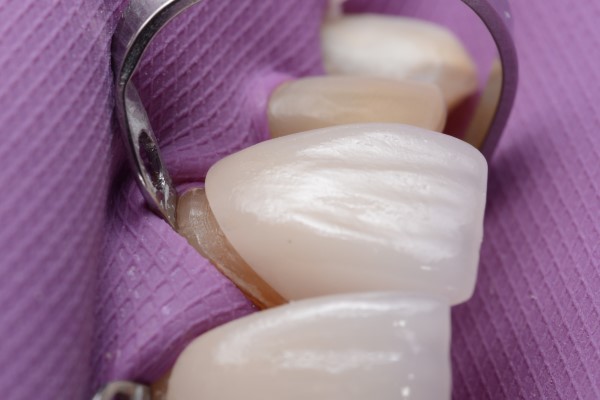Can Dental Veneers Be Removed?

If you have minor cosmetic issues, dental veneers may improve the look of your smile by covering them up. Veneers are thin shells of porcelain, ceramic, or composite materials that fit over the front of your teeth, making them appear whiter, straighter, healthier, or more evenly aligned. To securely mount the coverings in place, a dentist must first remove an outer layer of enamel and sometimes reshape the tooth for a natural-looking and even result.
Dental veneers are often recommended for minor or superficial damage because they are attached to the front of otherwise healthy teeth. Minor chips and cracks are fine, but severe decay or damage will require another treatment approach. In addition, the tooth root and gums must be healthy and stable before the treatment can take place.
If you wonder whether dental veneers can be removed, you should be clear about what you are asking. A dentist can take off veneers to replace them, but, in most cases, you cannot have veneers removed and go back to your original teeth. For these reasons, patients should carefully consider the commitment involved before choosing this treatment option.
Why are veneers removable?
Professional dental restoration treatments have a life expectancy of many years; the exact number varies depending on the treatment. Whatever the expected life span, it is understood that most restorations eventually have to be replaced. Dental veneers should last at least a decade. Nevertheless, their thin shells could be susceptible to chipping, cracking, or breaking. It is a relatively easy matter for the dentist to remove the old veneer and put a new one on. In that sense, the veneers are "removable."
There are several reasons why you might want to have veneers removed or replaced.
Stains
Veneers themselves are resistant to stains but the natural teeth around them are not. Veneers also cannot be whitened. To achieve a consistent color across all your teeth, you can either have your teeth whitened and replace the veneers to match or get new veneers that match the current color of your natural teeth.
Tooth decay
Veneers do not cover the entire tooth, only the front part. The exposed area in the back may still be vulnerable to decay. Repair of an underlying cavity requires the removal of the veneer, though it can be replaced later.
Damage
Veneers are vulnerable to the same types of things that can damage teeth, such as chewing on hard objects or a traumatic injury to the mouth. A broken or cracked veneer requires replacement.
Are dental veneers reversible?
In most cases, veneers are not reversible, meaning that you cannot change your mind about veneers and have them taken off without replacing them. For the veneers to adhere to your teeth, a portion of the enamel has to be removed. This makes the surface of your tooth rough so that the veneer is better able to attach to it. While only a small portion of enamel is removed, it is enough that if you were to have the veneer removed and not replace it, the rough areas would provide places for plaque to form and bacteria to grow. Additionally, you probably would not like the way it looked or felt.
There are exceptions in the form of no-prep and low-prep veneers that require less tooth enamel to be removed, or none at all. These types are considered reversible because whatever rough spots remain after the veneers are removed can be sanded down.
Other things to consider before choosing veneers
In addition to understanding the permanence of the treatment procedure, patients should also consider a few other implications before deciding on this treatment plan. Modifying your diet to avoid foods that can stain or damage veneers is essential to maintaining their appearance and stability. Alcohol should be consumed in moderation because it can wear down the adhesive at a much faster rate. People who clench or grind their teeth are more likely to damage veneers and should consider another alternative.
Even with routine care and a healthy lifestyle, a well-placed set of dental veneers will still require replacement eventually. Some patients need new coverings in about 10 years. Those with excellent oral health and habits can go as long as 20 years between treatments.
Conclusion
Before you decide to get dental veneers, you should weigh the decision carefully to make sure it is really what you want. While veneers can be removed by a dentist for purposes of replacing them, most are not reversible.
Request an appointment here: https://www.tanqueverdedental.com or call Oro Valley Family Dentistry at (520) 833-5261 for an appointment in our Tucson office.
Check out what others are saying about our dental services on Yelp: Dental Veneers and Dental Laminates in Tucson, AZ.
Related Posts
A dental veneer is a thin cap that fits over a damaged tooth. It creates the appearance of a new white tooth. Dental veneers are a popular option for repairing minor chips and damage. They can also make the teeth appear straight without resorting to orthodontics. Compared to surgery, fitting a dental veneer is a…
You can cover up imperfections in your teeth with dental veneers, thin shells of porcelain that fit over your teeth, and bond to them. Veneers can last for at least a decade, but they typically need to be replaced occasionally if a dentist must treat underlying tooth decay or gum disease. Veneers can also stain;…
Thinking about choosing a cosmetic dentist? Read on to learn more about what to consider during your search. To many patients, cosmetic dentistry is primarily a cosmetic enhancement. However, it often intersects with overall dental health. Therefore, it is important to consider several aspects before settling on a cosmetic dentist.Cosmetic dentists do more than enhance…
If you are more concerned about the appearance of your teeth than their function, cosmetic dentistry may offer the solutions you are looking for. There are a number of cosmetic treatments available to improve the size, shape, color, spacing, and apparent alignment of your teeth. The process usually begins with a consultation, during which you…


